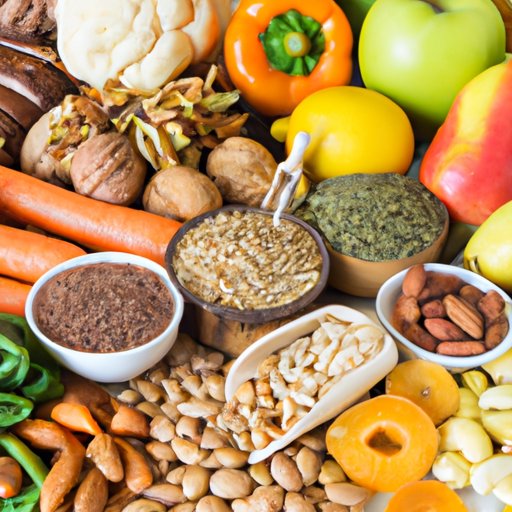Introduction
A high fiber diet is one that focuses on getting adequate amounts of dietary fiber from a variety of sources. Dietary fiber is an important part of a healthy diet since it can help reduce the risk of certain diseases, promote regularity, and even aid in weight loss. Additionally, it can help improve digestion and provide essential vitamins and minerals.
In general, a high fiber diet consists of eating a variety of whole grains, legumes, nuts and seeds, fruits, and vegetables. However, there are other sources of dietary fiber, such as supplements, that can be taken if necessary. In this article, we’ll explore what a high fiber diet is, the benefits of this type of diet, and how to get enough fiber in your diet.
What Foods Should You Include in a High Fiber Diet?
When it comes to eating a high fiber diet, there are several foods you should include in your diet. These include whole grains, legumes, nuts and seeds, fruits, and vegetables.
Whole Grains
Whole grains are a great source of dietary fiber and should be included in any high fiber diet. Examples of whole grains include oats, barley, quinoa, brown rice, and wheat. Whole grain breads and pastas are also good sources of fiber.
Legumes
Legumes, such as beans, lentils, and peas, are another excellent source of dietary fiber. They’re also packed with protein and other essential nutrients. Try adding them to salads, soups, and stews, or using them as a side dish.
Nuts and Seeds
Nuts and seeds are a great way to add fiber to your diet. They’re also a good source of healthy fats and other essential vitamins and minerals. Try snacking on almonds, walnuts, cashews, sunflower seeds, pumpkin seeds, and more.
Fruits and Vegetables
Fruits and vegetables are excellent sources of dietary fiber. Apples, oranges, bananas, berries, broccoli, spinach, and other leafy greens are all good choices. Aim to eat at least five servings of fruits and vegetables each day.
Other Sources
In addition to the foods mentioned above, there are other sources of dietary fiber. Chia seeds, flaxseeds, and psyllium husks are all good sources of fiber. Supplements such as Metamucil and Benefiber can also be taken to increase your fiber intake.
A Comprehensive Guide to Eating a High Fiber Diet
Eating a high fiber diet is beneficial for your overall health, but it can be difficult to know where to start. Here’s a comprehensive guide to help you get started.
How to Get Enough Fiber in Your Diet
The first step to getting enough fiber in your diet is to focus on incorporating more natural sources of fiber. This means eating more fruits, vegetables, whole grains, legumes, nuts, and seeds. Additionally, try to limit processed and refined foods, which are often low in fiber.
The Surprising Sources of Dietary Fiber
Many people don’t realize that there are numerous sources of dietary fiber. For example, oatmeal, chia seeds, and avocados are all good sources of fiber. It’s important to familiarize yourself with these sources so you can incorporate them into your diet.
Understanding the Different Types of Dietary Fiber
There are two main types of dietary fiber: soluble and insoluble. Soluble fiber absorbs water and forms a gel-like substance in the digestive tract, while insoluble fiber adds bulk to stool and helps food move through the digestive system. Both types of fiber are important for good health, so it’s important to make sure you’re getting enough of both.
A Beginner’s Guide to Adding More Fiber to Your Diet
If you’re just starting out on a high fiber diet, here are some tips to help you get started.
Start Small and Build Up Gradually
If you’re new to eating a high fiber diet, it’s best to start small and gradually increase your fiber intake. This will give your body time to adjust and help prevent any unpleasant side effects such as bloating or gas.
Focus on Incorporating More Natural Sources of Fiber
It’s important to focus on incorporating more natural sources of fiber into your diet. This means eating plenty of fruits, vegetables, whole grains, legumes, nuts, and seeds. Avoid processed and refined foods, which are usually low in fiber.
Consider Taking Supplements If Necessary
If you find it difficult to get enough fiber from food alone, consider taking supplements such as Metamucil or Benefiber. These can help you reach your recommended daily fiber intake without having to drastically change your diet.
Conclusion
A high fiber diet is an essential part of a healthy lifestyle. Eating a variety of whole grains, legumes, nuts and seeds, fruits, and vegetables can help you reach your recommended daily fiber intake. Additionally, consider taking supplements if necessary. With these tips and advice, you’ll be well on your way to eating a balanced, high fiber diet.
(Note: Is this article not meeting your expectations? Do you have knowledge or insights to share? Unlock new opportunities and expand your reach by joining our authors team. Click Registration to join us and share your expertise with our readers.)
